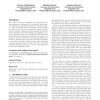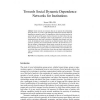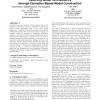178 search results - page 8 / 36 » Representing social structures in UML |
SIGECOM
2009
ACM
14 years 2 months ago
2009
ACM
We consider models for bargaining in social networks, in which players are represented by vertices and edges represent bilateral opportunities for deals between pairs of players. ...
OTM
2007
Springer
14 years 1 months ago
2007
Springer
Environmental engineers from different organizations work in interdisciplinary projects having the need of information exchange. In particular, a collaborative environment with pe...
STAIRS
2008
13 years 9 months ago
2008
Social networks are structures that aim to represent the relationships among the actors of a society. In the multiagent model, these networks depict the dependencies among the agen...
WCRE
2002
IEEE
14 years 11 days ago
2002
IEEE
Today, software-engineering research and industry alike recognize the need for practical tools to support reverseengineering activities. Most of the well-known CASE tools support ...
ICSE
2008
IEEE-ACM
14 years 8 months ago
2008
IEEE-ACM
Nowadays, large-scale industrial software systems may involve hundreds of developers working on hundreds of different but related models representing parts of the same system spec...



